Get ready for… Nanosoccer!
Last updated Sep 22, 2008 — 13436 views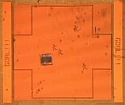 “Imagine a robotic David Beckham six times smaller than an amoeba playing with a ‘soccer ball’ no wider than a human hair … with all of the action happening on a field the size of single grain of rice.”
“Imagine a robotic David Beckham six times smaller than an amoeba playing with a ‘soccer ball’ no wider than a human hair … with all of the action happening on a field the size of single grain of rice.”
That’s how the U.S. National Institute of Standards and Technology (NIST) describes “nanosoccer” — its latest team sport for universities with programs in micro-electro-mechanical systems (MEMS).
Nanosoccer competitions were first publicly demonstrated last year at the international RoboCup competition in Atlanta, Ga., and were showcased again this year at the RoboCup U.S. Open in Pittsburgh, Penna. So far, participating schools have included Carnegie Mellon University, the U.S. Naval Academy, the Swiss Federal Institute of Technolog, Simon Fraser University (Canada), and the University of Waterloo (Canada).
Nanosoccer playing field layout
(Click image to enlarge)
The soccer nanobots, operated by human players via remote-controlled electric and magnetic fields, push tiny discs around on a 2.5 x 2.5 mm playing field. The human players view the competition through an optical microscope.
The competition consists of three events:
- Two-millimeter dash — the nanobots race across the playing field as fast as possible
- Obstacle course — the nanobots must successfully traverse a path blocked by “polymer post” defenders
- Ball handling drill — the nanobots dribble as many “nanoballs” as possible into the goal within 3 minutes
False-color SEM micrograph of Carnegie Mellon’s 300x300x100 micron magnetic micro-robot with a claw
(Source: Carnegie Mellon University)
The tiny nanobots are constructed from aluminum, chromium, gold, nickel, and silicon. They weigh between a few nanograms and a few hundred nanograms, and measure from a few tens of micrometers to a few hundred micrometers, NIST says.

Chip with 16 playing fields (left); shown mounted on a circuit board (right)
(Click each image to enlarge)
Sixteen nanosoccer playing fields are built onto a single silicon chip (photo above-left) that’s roughly the size of a quarter. The the playing-field chip is mounted on a small circuit board assembly, along with interface connectors (photo above-right).
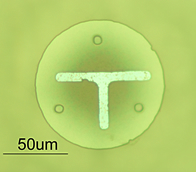 Each nanosoccer “ball” (photo at right) consists of a silicon dioxide disk approximately the diameter of a human hair, NIST says. Each disk has a T-shaped marking, to help the human players locate it on the playing field. The three small circles correspond to a set of tiny bumps on the bottom of the disk; these reduce friction, making it easier for the disks to slide across the playing field.
Each nanosoccer “ball” (photo at right) consists of a silicon dioxide disk approximately the diameter of a human hair, NIST says. Each disk has a T-shaped marking, to help the human players locate it on the playing field. The three small circles correspond to a set of tiny bumps on the bottom of the disk; these reduce friction, making it easier for the disks to slide across the playing field.
The following short NIST-produced video demonstrates the nanosoccer technologies, the RoboCup nanosoccer competition, and some potential applications for the technology:
Nanosoccer demonstration video
(Click image to play video)
NIST expects programs such as soccer nanobots to eventually yield practical applications such as “microsurgery within the human body or the manufacturing of atom-sized components for microscopic electronic devices.” It’s not difficult to think up lots of other interesting — and potentially bizarre — applications.
The next big nanosoccer face-off is slated for RoboCup 2009, to be held from June 29 to July 5 next year in Graz, Austria. Don’t forget to bring your microscope!


[All photos are courtesy of the National Institute of Standards and Technology.]


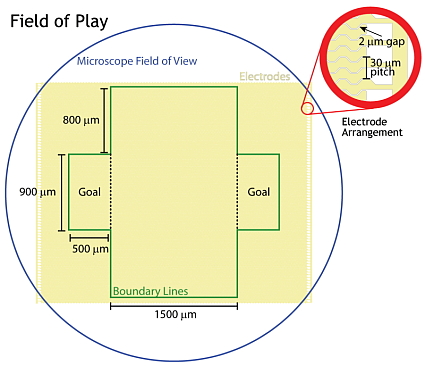
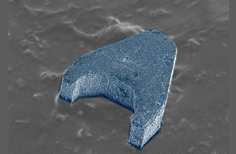
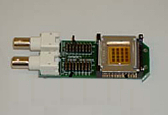
is the human hair width a NIST standard?
That is really cool! When I see NIST, I normally think of a bunch of boring statisticians poring over figures and tech manuals. Boy was I wrong! How would a guy get a job there?